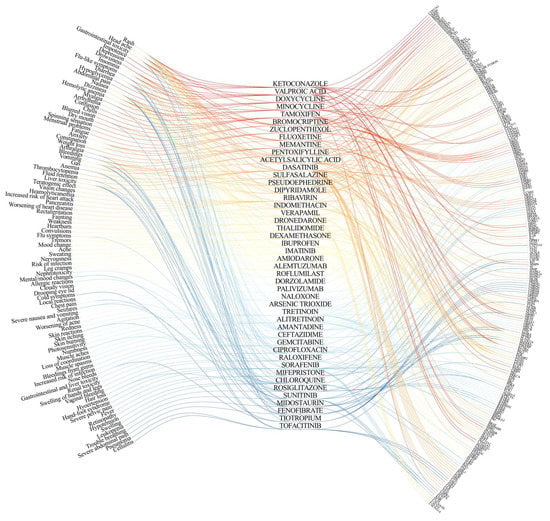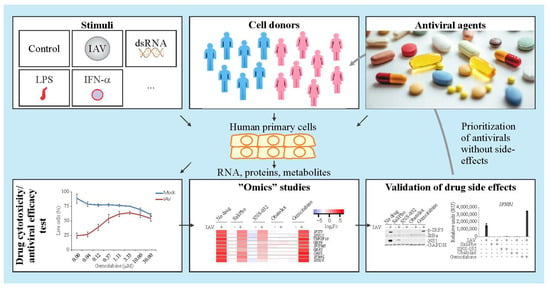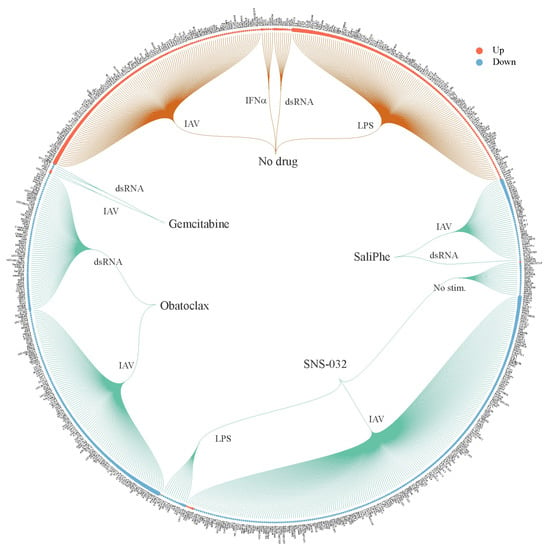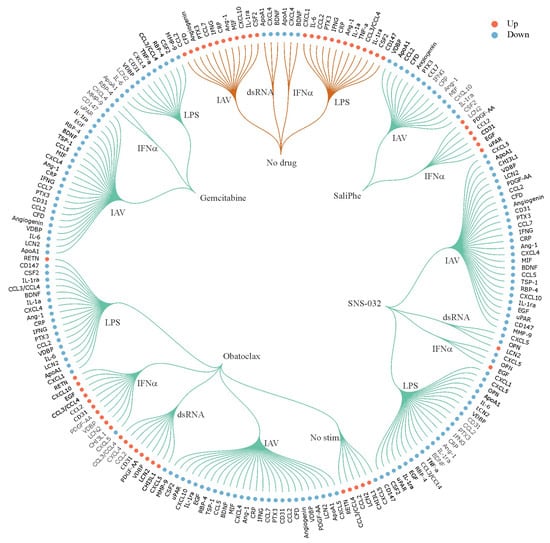Abstract
There are dozens of approved, investigational and experimental antiviral agents. Many of these agents cause serious side effects, which can only be revealed after drug administration. Identification of the side effects prior to drug administration is challenging. Here we describe an ex vivo approach for studying immuno- and neuro-modulatory properties of antiviral agents, which may be associated with potential side effects of these therapeutics. The current approach combines drug toxicity/efficacy tests and transcriptomics, which is followed by mRNA, cytokine and metabolite profiling. We demonstrated the utility of this approach with several examples of antiviral agents. We also showed that the approach can utilize different immune stimuli and cell types. It can also include other omics techniques, such as genomics and epigenomics, to allow identification of individual markers associated with adverse reactions to antivirals with immuno- and neuro-modulatory properties.
1. Introduction
Altogether, 58 known viruses belonging to 20 viral families represent global threats, which are associated with public health concerns and economic burden []. Antiviral drugs are powerful tools to control some of the viral diseases. To date, 86 drugs have been approved for the treatment of 17 viral infections []. However, some of these agents possess severe side effects [,,]. For example, anti-HCV ribavirin causes hemolytic anemia when used long-term; anti-IAV zanamivir worsens breathing in patients with asthma; and anti-HIV drug, rescriptor, can cause severe rashes and lipodystrophy [,,,]. The most common side effects for other approved antivirals are nausea, vomiting, allergic reactions, drowsiness, insomnia, behavioral abnormalities, heart problems and dependence (Table S1).
In some cases, the side effects of approved antivirals were discovered during clinical trials and considered as an acceptable risk, whereas, in other cases, the side effects remained unknown until after the drugs were widely used. The latter cases have led to several post-market drug withdrawals, changes in labels, the introduction of new black-box warnings or recommendations []. For example, telaprevir and ribavirin were withdrawn after the serious adverse reactions in HCV-infected patients, including skin reactions and birth defects []. Amantadine and rimantadine were not recommended for the treatment of IAV infections in 2009, because 100% of the seasonal, as well as the 2009 influenza pandemic strains, carried resistance to the drugs []. Amantadine side effects were also associated with the impairment of central nervous system activity [].
In addition, there are 116 investigational antiviral agents []. However, many of these agents have shown severe side effects during phase I, II or III of clinical trials, which prevented them from reaching FDA approval and the market. For example, FDA rejected pleconaril, a drug that prevents common cold symptoms in patients exposed to picornavirus respiratory infections. The decision was based on symptoms such as headache, diarrhea, painful nasal inflammation and nausea as well as emerging drug resistance associated with the treatment [].
Moreover, there are hundreds of experimental antiviral agents []. The side effects of many of these agents remain unknown because initial studies have mainly focused on the mechanism of action and therapeutic effects of these compounds. Here, we describe an ex vivo approach to study immuno- and neuro-modulatory properties of prospective antiviral agents. The current approach combines drug toxicity and efficacy tests with genome-wide transcriptomics followed by cytokine and metabolite profiling. We demonstrate the utility of this approach with several examples. Further development of some of these antivirals could be prioritized based on their immuno- and neuro-modulatory profiles.
4. Advantages and Disadvantages of the Approach
The approach can utilize different antiviral agents. We showed recently that JNJ872, which inhibited the transcription and replication of IAV RNA, did not alter cellular antiviral responses at the transcriptional, translational or metabolic levels in human macrophages []. By contrast, Akt inhibitor MK2206, which blocks IAV entry, prevented the development of antiviral responses in human non-small-cell lung cancer NCI-H1666 cells []. In addition, antiviral Bcl-2 inhibitors including ABT-263 and A-1155463 limited activation of antiviral responses in different cell cultures by inducing the premature death of infected cells [,,]. Thus, the development of JNJ872 should be prioritized because this agent allows development of innate immune and metabolic responses during IAV infection.
Moreover, the current approach can be used to study immune- and neuro-modulatory properties of drugs, which are prescribed for the treatment of underlying diseases in infected patients, such as hypertension, thyroid hormone deficiency and insomnia. This could allow identification of immune- and neuro-modulatory profiles of drugs, the use of which should be omitted in these patients.
The approach can also utilize different cell types such as human monocytes, fibroblasts, epithelial cells of the respiratory or intestinal tract, IPS-derived cell cultures and co-cultures. In our proof-of-concept experiment, we used PBMC-derived macrophages, which differentiation takes 7–10 days. The differentiation step, however, could be omitted, because PBMCs are also susceptible to IAV infection and dsRNA-, IFN-α-, and LPS- stimulation.
In addition, the approach can use other immune stimuli, including ZIKV, CHIKV, HSV-1, and HIV-1, which infect human monocytes as well as other cell types, which represent natural targets for different viruses [,,,]. For example, we showed recently that SaliPhe, obatoclax, and gemcitabine affected transcription, translation and posttranslational modifications of cellular factors as well as metabolic pathways in ZIKV-infected human RPE cells [].
The current approach can also utilize genomics and epigenomics [,]. Both techniques were used successfully to link certain viral diseases with genetic variants and epigenetic markers in resting and stimulated monocytes and dendritic cells [,,,,,]. Tying these techniques with transcriptomics, proteomics and metabolomics could allow identification of biomarkers for side effect susceptibility and provide a better understanding of how genetic and epigenetic variations contribute to the efficacy of treatment of viral infections.
The main disadvantages of the approach, however, is time and costs associated with the experimental setup, omics experiments, data analysis, integration and interpretation. To save time and resources, all analyses should be performed on a single batch of patient cells. In addition, omics studies should be harmonized and target more cytokines (including IFN-β) and metabolites (including prostaglandins). Moreover, the data should be relatively easily annotated, standardized, curated, integrated and interpreted.
5. Future Perspectives: Personalized Treatment of Viral Diseases
To date, many viral infections are diagnosed using PCR- or antibody-based tests. Clinicians evaluate the results of these tests and prescribe treatment for infected patients (Figure 6, upper panel). However, not all patients respond to the standard treatments. Therefore, personalized treatment solutions could become an option for the non-responders []. In particular, drug sensitivity screening in resting and infected patient primary cells could identify effective therapeutics among the approved and investigational antiviral agents. This approach, however, will work the best for chronic (such as HCV, HIV, CMV, and HPV), but not acute viral infections, where time is the main constraint.
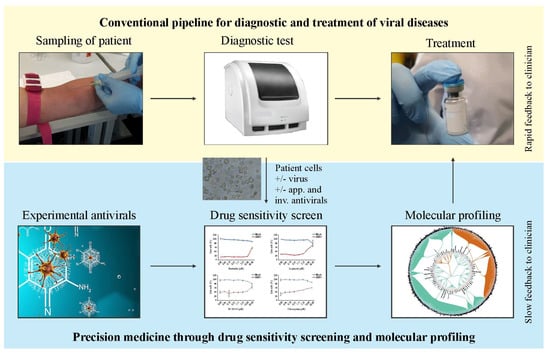
Figure 6.
Added value of the systems approach. Systems approaches will guide the evaluation of novel antivirals and their side effects and implementation into personalized medicine pipeline.
Moreover, the number of approved and investigational antivirals is insufficient for the treatment of the entire spectrum of viral infections. This problem could be solved by feeding the drug screens with experimental antiviral compounds, which have been approved for the treatment of non-viral diseases. To our knowledge, there are more than 160 agents with available safety profiles in humans []. The drug sensitivity screens followed by molecular profiling of side effects could identify experimental compounds with acceptable immune- and neuro-modulatory effects. Clinicians could assess the screening results, correctly choose between drug options and decide on appropriate dosing and regimen (Figure 6, lower panel).
6. Conclusions
There are two sides of the same coin: therapeutic and adverse effects of antivirals. The side effects are usually revealed only after administrating the drugs to patients. Identification of the side effects before drug administration is challenging. Here, we described a systems biology approach, which generates an immune- and neuro-modulatory profile of an antiviral agent using patient cells and different immune stimuli. These profiles allow for the identification of antivirals, which could modulate immune and neurological responses in patients. Based on these profiles, clinicians could prioritize treatment solution for infected patients.
To extract higher value from our study, a harmonized bioactivity data annotation, standardization, curation, and intra-resource integration are needed. We invite other researchers and clinicians to improve the systems biology approach and to test immune- and neuro-modulatory effects of their agents. Tying this approach with patient-specific genetic data and medical records will allow for population-based drug adverse events in cross-sectional studies. Altogether, these studies may decrease mortality of infected patients, maximize the number of healthy life years, and improve the quality of life and cost-effectiveness of patient care.
Supplementary Materials
The following are available online at http://www.mdpi.com/1999-4915/10/8/423/s1. Table S1: Approved, investigational and experimental antiviral agents and their side effects, Table S2: SaliPhe, SNS-032, obatoclax and gemcitabine differentially affect transcription of immune-related genes in stimulated human PBMC-derived macrophages, Table S3: SaliPhe, SNS-032, obatoclax and gemcitabine differentially affect production of cytokines and growth factors by stimulated human PBMC-derived macrophages, Table S4: SaliPhe, SNS-032, obatoclax and gemcitabine, differentially affect production of several polar metabolites by stimulated PBMC-derived macrophages.
Author Contributions
Conceptualization, D.E.K.; Formal Analysis, A.I. and E.Z.; Data Curation & Visualization, A.I. and D.E.K,; Writing-Original Draft Preparation, A.I., E.Z. and D.E.K.; Writing-Review & Editing, E.Z., A.I., D.N., M.M.P., M.B., J.E.A., T.T., V.V., A.M. and D.E.K.; Project Administration, D.E.K.; Funding Acquisition, D.E.K.
Funding
This research was funded by Estonian Research Council Mobilitas pluss top researcher grant (contract No. MOBTT3).
Acknowledgments
We thank Riitta Tarkiainen for technical assistance. This work was funded by Mobilitas pluss top researcher grant (contract No. MOBTT39, to D.E.K.).
Conflicts of Interest
The authors declare no conflict of interest.
Abbreviations
PBMC: peripheral blood mononuclear cells; FDA: food and drug administration; IAV: influenza A virus; HIV: human immunodeficiency virus; ZIKV: Zika virus; RPE: retinal pigment epithelium; LPS: lipopolysaccharides; IFN: interferon; dsRNA: double-stranded RNA; SaliPhe: saliphenylhalamide; PAMP: pathogen-associated molecular patterns; TMAO: trimethylamine N-oxide; FluBV: influenza B virus; WNV: West Nile virus; JEV: Japanese encephalitis virus; SINV: Sindbis virus; BUNV: Bunyamwera virus; vATPase: vacuolar ATPase; Mcl-1: induced myeloid leukemia cell differentiation protein; CHIKV: Chikungunya virus; YFV: Yellow fever virus; RNR: ribonucleoside-diphosphate reductase; CDKs: cyclin-dependent protein kinases; NSAIDs: nonsteroidal anti-inflammatory drugs; HPV: human papilloma virus; HEV-B: human enterovirus B; HRV-A: human rhinovirus A; HSV-1: herpes simplex virus 1; PV: poliovirus; VACV: Vaccinia virus.
References
- Ianevski, A.; Zusinaite, E.; Kuivanen, S.; Strand, M.; Lysvand, H.; Teppor, M.; Kakkola, L.; Paavilainen, H.; Laajala, M.; Kallio-Kokko, H.; et al. Novel activities of safe-in-human broad-spectrum antiviral agents. Antivir. Res. 2018, 154, 174–182. [Google Scholar] [CrossRef] [PubMed]
- De Clercq, E.; Li, G. Approved Antiviral Drugs over the Past 50 Years. Clin. Microbiol. Rev. 2016, 29, 695–747. [Google Scholar] [CrossRef] [PubMed]
- Smith, L.E.; D’Antoni, D.; Jain, V.; Pearce, J.M.; Weinman, J.; Rubin, G.J. A systematic review of factors affecting intended and actual adherence with antiviral medication as treatment or prophylaxis in seasonal and pandemic flu. Influ. Other Respir. Viruses 2016, 10, 462–478. [Google Scholar] [CrossRef] [PubMed]
- Esposito, I.; Labarga, P.; Barreiro, P.; Fernandez-Montero, J.V.; de Mendoza, C.; Benitez-Gutierrez, L.; Pena, J.M.; Soriano, V. Dual antiviral therapy for HIV and hepatitis C—Drug interactions and side effects. Expert Opin. Drug Saf. 2015, 14, 1421–1434. [Google Scholar] [CrossRef] [PubMed]
- Reust, C.E. Common adverse effects of antiretroviral therapy for HIV disease. Am. Fam. Phys. 2011, 83, 1443–1451. [Google Scholar]
- Esposito, I.; Benitez-Gutierrez, L.; Trevino, A.; Arias, A.; Citores, M.J.; Requena, S.; Soriano, V.; Cuervas-Mons, V.; de Mendoza, C. Impact of ITPA gene polymorphisms on the risk of ribavirin-induced haemolytic anaemia using interferon-free antivirals for chronic hepatitis C. Antivir. Ther. 2017, 22, 571–575. [Google Scholar] [CrossRef] [PubMed]
- Guaraldi, G.; Stentarelli, C.; Zona, S.; Santoro, A. HIV-associated lipodystrophy: Impact of antiretroviral therapy. Drugs 2013, 73, 1431–1450. [Google Scholar] [CrossRef] [PubMed]
- Keiser, M.J.; Setola, V.; Irwin, J.J.; Laggner, C.; Abbas, A.I.; Hufeisen, S.J.; Jensen, N.H.; Kuijer, M.B.; Matos, R.C.; Tran, T.B.; et al. Predicting new molecular targets for known drugs. Nature 2009, 462, 175–181. [Google Scholar] [CrossRef] [PubMed]
- Williamson, J.C.; Pegram, P.S. Neuraminidase inhibitors in patients with underlying airways disease. Am. J. Respir. Med. 2002, 1, 85–90. [Google Scholar] [CrossRef] [PubMed]
- Onakpoya, I.J.; Heneghan, C.J.; Aronson, J.K. Post-marketing withdrawal of 462 medicinal products because of adverse drug reactions: A systematic review of the world literature. BMC Med. 2016, 14, 10. [Google Scholar] [CrossRef] [PubMed]
- Siramshetty, V.B.; Nickel, J.; Omieczynski, C.; Gohlke, B.O.; Drwal, M.N.; Preissner, R. WITHDRAWN—A resource for withdrawn and discontinued drugs. Nucleic Acids Res. 2016, 44, D1080–D1086. [Google Scholar] [CrossRef] [PubMed]
- Belanov, S.S.; Bychkov, D.; Benner, C.; Ripatti, S.; Ojala, T.; Kankainen, M.; Kai Lee, H.; Wei-Tze Tang, J.; Kainov, D.E. Genome-Wide Analysis of Evolutionary Markers of Human Influenza A(H1N1)pdm09 and A(H3N2) Viruses May Guide Selection of Vaccine Strain Candidates. Genome Biol. Evol. 2015, 7, 3472–3483. [Google Scholar] [CrossRef] [PubMed]
- Kaefer, V.; Semedo, J.G.; Silva Kahl, V.F.; Von Borowsky, R.G.; Gianesini, J.; Ledur Kist, T.B.; Pereira, P.; Picada, J.N. DNA damage in brain cells and behavioral deficits in mice after treatment with high doses of amantadine. J. Appl. Toxicol. 2010, 30, 745–753. [Google Scholar] [CrossRef] [PubMed]
- Benschop, K.S.; Wildenbeest, J.G.; Koen, G.; Minnaar, R.P.; van Hemert, F.J.; Westerhuis, B.M.; Pajkrt, D.; van den Broek, P.J.; Vossen, A.C.; Wolthers, K.C. Genetic and antigenic structural characterization for resistance of echovirus 11 to pleconaril in an immunocompromised patient. J. Gen. Virol. 2015, 96, 571–579. [Google Scholar] [CrossRef] [PubMed]
- Mercorelli, B.; Palu, G.; Loregian, A. Drug Repurposing for Viral Infectious Diseases: How Far Are We? Trends Microbiol. 2018. [Google Scholar] [CrossRef] [PubMed]
- Berger, S.I.; Iyengar, R. Role of systems pharmacology in understanding drug adverse events. Wiley Interdiscip. Rev. Syst. Biol. Med. 2011, 3, 129–135. [Google Scholar] [CrossRef] [PubMed]
- Gallay, P.A.; Lin, K. Profile of alisporivir and its potential in the treatment of hepatitis C. Drug Des. Dev. Ther. 2013, 7, 105–115. [Google Scholar] [CrossRef] [PubMed]
- Sharma, V.D.; Lyons, K.E.; Pahwa, R. Amantadine extended-release capsules for levodopa-induced dyskinesia in patients with Parkinson’s disease. Ther. Clin. Risk Manag. 2018, 14, 665–673. [Google Scholar] [CrossRef] [PubMed]
- Schor, S.; Einav, S. Repurposing of Kinase Inhibitors as Broad-Spectrum Antiviral Drugs. DNA Cell Biol. 2018, 37, 63–69. [Google Scholar] [CrossRef] [PubMed]
- Soderholm, S.; Anastasina, M.; Islam, M.M.; Tynell, J.; Poranen, M.M.; Bamford, D.H.; Stenman, J.; Julkunen, I.; Sauliene, I.; De Brabander, J.K.; et al. Immuno-modulating properties of saliphenylhalamide, SNS-032, obatoclax, and gemcitabine. Antivir. Res. 2016, 126, 69–80. [Google Scholar] [CrossRef] [PubMed]
- Soderholm, S.; Kainov, D.E.; Ohman, T.; Denisova, O.V.; Schepens, B.; Kulesskiy, E.; Imanishi, S.Y.; Corthals, G.; Hintsanen, P.; Aittokallio, T.; et al. Phosphoproteomics to Characterize Host Response During Influenza A Virus Infection of Human Macrophages. Mol. Cell. Proteom. 2016, 15, 3203–3219. [Google Scholar] [CrossRef] [PubMed]
- Kuivanen, S.; Bespalov, M.M.; Nandania, J.; Ianevski, A.; Velagapudi, V.; De Brabander, J.K.; Kainov, D.E.; Vapalahti, O. Obatoclax, saliphenylhalamide and gemcitabine inhibit Zika virus infection in vitro and differentially affect cellular signaling, transcription and metabolism. Antivir. Res. 2017, 139, 117–128. [Google Scholar] [CrossRef] [PubMed]
- Varghese, F.S.; Rausalu, K.; Hakanen, M.; Saul, S.; Kummerer, B.M.; Susi, P.; Merits, A.; Ahola, T. Obatoclax Inhibits Alphavirus Membrane Fusion by Neutralizing the Acidic Environment of Endocytic Compartments. Antimicrob. Agents Chemother. 2017, 61. [Google Scholar] [CrossRef] [PubMed]
- Adcock, R.S.; Chu, Y.K.; Golden, J.E.; Chung, D.H. Evaluation of anti-Zika virus activities of broad-spectrum antivirals and NIH clinical collection compounds using a cell-based, high-throughput screen assay. Antivir. Res. 2017, 138, 47–56. [Google Scholar] [CrossRef] [PubMed]
- Muller, K.H.; Spoden, G.A.; Scheffer, K.D.; Brunnhofer, R.; De Brabander, J.K.; Maier, M.E.; Florin, L.; Muller, C.P. Inhibition by cellular vacuolar ATPase impairs human papillomavirus uncoating and infection. Antimicrob. Agents Chemother. 2014, 58, 2905–2911. [Google Scholar] [CrossRef] [PubMed]
- Denisova, O.V.; Kakkola, L.; Feng, L.; Stenman, J.; Nagaraj, A.; Lampe, J.; Yadav, B.; Aittokallio, T.; Kaukinen, P.; Ahola, T.; et al. Obatoclax, saliphenylhalamide, and gemcitabine inhibit influenza a virus infection. J. Biol. Chem. 2012, 287, 35324–35332. [Google Scholar] [CrossRef] [PubMed]
- Morales, F.; Giordano, A. Overview of CDK9 as a target in cancer research. Cell Cycl. 2016, 15, 519–527. [Google Scholar] [CrossRef] [PubMed]
- Lebreton, S.; Jaunbergs, J.; Roth, M.G.; Ferguson, D.A.; De Brabander, J.K. Evaluating the potential of vacuolar ATPase inhibitors as anticancer agents and multigram synthesis of the potent salicylihalamide analog saliphenylhalamide. Bioorg. Med. Chem. Lett. 2008, 18, 5879–5883. [Google Scholar] [CrossRef] [PubMed]
- Lee, M.N.; Ye, C.; Villani, A.C.; Raj, T.; Li, W.; Eisenhaure, T.M.; Imboywa, S.H.; Chipendo, P.I.; Ran, F.A.; Slowikowski, K.; et al. Common genetic variants modulate pathogen-sensing responses in human dendritic cells. Science 2014, 343, 1246980. [Google Scholar] [CrossRef] [PubMed]
- Baba, T.; Mukaida, N. Role of macrophage inflammatory protein (MIP)-1alpha/CCL3 in leukemogenesis. Mol. Cell. Oncol. 2014, 1, e29899. [Google Scholar] [CrossRef] [PubMed]
- Robertson, M.J. Role of chemokines in the biology of natural killer cells. J. Leukoc. Biol. 2002, 71, 173–183. [Google Scholar] [PubMed]
- Koper, O.M.; Kaminska, J.; Sawicki, K.; Kemona, H. CXCL9, CXCL10, CXCL11, and their receptor (CXCR3) in neuroinflammation and neurodegeneration. Adv. Clin. Exp. Med. 2018, 27, 849–856. [Google Scholar] [CrossRef] [PubMed]
- Ferrari, S.M.; Ruffilli, I.; Colaci, M.; Antonelli, A.; Ferri, C.; Fallahi, P. CXCL10 in psoriasis. Adv. Med. Sci. 2015, 60, 349–354. [Google Scholar] [CrossRef] [PubMed]
- Antonelli, A.; Ferrari, S.M.; Giuggioli, D.; Ferrannini, E.; Ferri, C.; Fallahi, P. Chemokine (C-X-C motif) ligand (CXCL)10 in autoimmune diseases. Autoimmun. Rev. 2014, 13, 272–280. [Google Scholar] [CrossRef] [PubMed]
- Gaelings, L.; Soderholm, S.; Bugai, A.; Fu, Y.; Nandania, J.; Schepens, B.; Lorey, M.B.; Tynell, J.; Vande Ginste, L.; Le Goffic, R.; et al. Regulation of kynurenine biosynthesis during influenza virus infection. FEBS J. 2017, 284, 222–236. [Google Scholar] [CrossRef] [PubMed]
- Duan, Z.; Duan, Y.; Lei, H.; Hu, N.; Shi, J.; Shen, D.; Wang, X.; Hu, Y. Attenuation of antigenic immunogenicity by kynurenine, a novel suppressive adjuvant. Hum. Vaccines Immunother. 2014, 10, 1295–1305. [Google Scholar] [CrossRef] [PubMed]
- Liu, X.C.; Holtze, M.; Powell, S.B.; Terrando, N.; Larsson, M.K.; Persson, A.; Olsson, S.K.; Orhan, F.; Kegel, M.; Asp, L.; et al. Behavioral disturbances in adult mice following neonatal virus infection or kynurenine treatment--role of brain kynurenic acid. Brain Behav. Immun. 2014, 36, 80–89. [Google Scholar] [CrossRef] [PubMed]
- Lucido, M.J.; Orlando, B.J.; Vecchio, A.J.; Malkowski, M.G. Crystal Structure of Aspirin-Acetylated Human Cyclooxygenase-2: Insight into the Formation of Products with Reversed Stereochemistry. Biochemistry 2016, 55, 1226–1238. [Google Scholar] [CrossRef] [PubMed]
- Antonioli, L.; Csoka, B.; Fornai, M.; Colucci, R.; Kokai, E.; Blandizzi, C.; Hasko, G. Adenosine and inflammation: What’s new on the horizon? Drug Discov. Today. 2014, 19, 1051–1068. [Google Scholar] [CrossRef] [PubMed]
- Benarroch, E.E. Adenosine and its receptors: Multiple modulatory functions and potential therapeutic targets for neurologic disease. Neurology 2008, 70, 231–236. [Google Scholar] [CrossRef] [PubMed]
- Tang, W.H.; Wang, Z.; Levison, B.S.; Koeth, R.A.; Britt, E.B.; Fu, X.; Wu, Y.; Hazen, S.L. Intestinal microbial metabolism of phosphatidylcholine and cardiovascular risk. N. Engl. J. Med. 2013, 368, 1575–1584. [Google Scholar] [CrossRef] [PubMed]
- Fu, Y.; Gaelings, L.; Soderholm, S.; Belanov, S.; Nandania, J.; Nyman, T.A.; Matikainen, S.; Anders, S.; Velagapudi, V.; Kainov, D.E. JNJ872 inhibits influenza A virus replication without altering cellular antiviral responses. Antivir. Res. 2016, 133, 23–31. [Google Scholar] [CrossRef] [PubMed]
- Denisova, O.V.; Soderholm, S.; Virtanen, S.; Von Schantz, C.; Bychkov, D.; Vashchinkina, E.; Desloovere, J.; Tynell, J.; Ikonen, N.; Theisen, L.L.; et al. Akt inhibitor MK2206 prevents influenza pH1N1 virus infection in vitro. Antimicrob. Agents Chemother. 2014, 58, 3689–3696. [Google Scholar] [CrossRef] [PubMed]
- Bulanova, D.; Ianevski, A.; Bugai, A.; Akimov, Y.; Kuivanen, S.; Paavilainen, H.; Kakkola, L.; Nandania, J.; Turunen, L.; Ohman, T.; et al. Antiviral Properties of Chemical Inhibitors of Cellular Anti-Apoptotic Bcl-2 Proteins. Viruses 2017, 9, 271. [Google Scholar] [CrossRef] [PubMed]
- Shim, J.M.; Kim, J.; Tenson, T.; Min, J.Y.; Kainov, D.E. Influenza Virus Infection, Interferon Response, Viral Counter-Response, and Apoptosis. Viruses 2017, 9, 223. [Google Scholar] [CrossRef] [PubMed]
- Kakkola, L.; Denisova, O.V.; Tynell, J.; Viiliainen, J.; Ysenbaert, T.; Matos, R.C.; Nagaraj, A.; Ohman, T.; Kuivanen, S.; Paavilainen, H.; et al. Anticancer compound ABT-263 accelerates apoptosis in virus-infected cells and imbalances cytokine production and lowers survival rates of infected mice. Cell Death Dis. 2013, 4, e742. [Google Scholar] [CrossRef] [PubMed]
- Jurado, K.A.; Iwasaki, A. Zika virus targets blood monocytes. Nat. Microbiol. 2017, 2, 1460–1461. [Google Scholar] [CrossRef] [PubMed]
- Marino-Merlo, F.; Papaianni, E.; Medici, M.A.; Macchi, B.; Grelli, S.; Mosca, C.; Borner, C.; Mastino, A. HSV-1-induced activation of NF-kappaB protects U937 monocytic cells against both virus replication and apoptosis. Cell Death Dis. 2016, 7, e2354. [Google Scholar] [CrossRef] [PubMed]
- Kumar, A.; Abbas, W.; Herbein, G. HIV-1 latency in monocytes/macrophages. Viruses 2014, 6, 1837–1860. [Google Scholar] [CrossRef] [PubMed]
- Her, Z.; Malleret, B.; Chan, M.; Ong, E.K.; Wong, S.C.; Kwek, D.J.; Tolou, H.; Lin, R.T.; Tambyah, P.A.; Renia, L.; et al. Active infection of human blood monocytes by Chikungunya virus triggers an innate immune response. J. Immunol. 2010, 184, 5903–5913. [Google Scholar] [CrossRef] [PubMed]
- Wishart, D.S.; Feunang, Y.D.; Guo, A.C.; Lo, E.J.; Marcu, A.; Grant, J.R.; Sajed, T.; Johnson, D.; Li, C.; Sayeeda, Z.; et al. DrugBank 5.0: A major update to the DrugBank database for 2018. Nucleic Acids Res. 2018, 46, D1074–D1082. [Google Scholar]
- Beger, R.D.; Dunn, W.; Schmidt, M.A.; Gross, S.S.; Kirwan, J.A.; Cascante, M.; Brennan, L.; Wishart, D.S.; Oresic, M.; Hankemeier, T.; et al. Metabolomics enables precision medicine: “A White Paper, Community Perspective”. Metabolomics 2016, 12, 149. [Google Scholar] [CrossRef] [PubMed]
- Wang, H.; Wang, J.; Ning, C.; Zheng, X.; Fu, J.; Wang, A.; Zhang, Q.; Liu, J.F. Genome-wide DNA methylation and transcriptome analyses reveal genes involved in immune responses of pig peripheral blood mononuclear cells to poly I:C. Sci. Rep. 2017, 7, 9709. [Google Scholar] [CrossRef] [PubMed]
- Yan, H.; Tian, S.; Slager, S.L.; Sun, Z.; Ordog, T. Genome-Wide Epigenetic Studies in Human Disease: A Primer on-Omic Technologies. Am. J. Epidemiol. 2016, 183, 96–109. [Google Scholar] [CrossRef] [PubMed]
- Yip, V.L.; Alfirevic, A.; Pirmohamed, M. Genetics of immune-mediated adverse drug reactions: A comprehensive and clinical review. Clin. Rev. Allergy Immunol. 2015, 48, 165–175. [Google Scholar] [CrossRef] [PubMed]
- Fairfax, B.P.; Humburg, P.; Makino, S.; Naranbhai, V.; Wong, D.; Lau, E.; Jostins, L.; Plant, K.; Andrews, R.; McGee, C.; et al. Innate immune activity conditions the effect of regulatory variants upon monocyte gene expression. Science 2014, 343, 1246949. [Google Scholar] [CrossRef] [PubMed]
- Rotival, M.; Zeller, T.; Wild, P.S.; Maouche, S.; Szymczak, S.; Schillert, A.; Castagne, R.; Deiseroth, A.; Proust, C.; Brocheton, J.; et al. Integrating genome-wide genetic variations and monocyte expression data reveals trans-regulated gene modules in humans. PLoS Genet. 2011, 7, e1002367. [Google Scholar] [CrossRef] [PubMed]
- Ginsburg, G.S.; McCarthy, J.J. Personalized medicine: Revolutionizing drug discovery and patient care. Trends Biotechnol. 2001, 19, 491–496. [Google Scholar] [CrossRef]
© 2018 by the authors. Licensee MDPI, Basel, Switzerland. This article is an open access article distributed under the terms and conditions of the Creative Commons Attribution (CC BY) license (http://creativecommons.org/licenses/by/4.0/).
